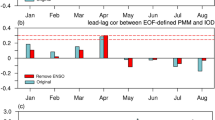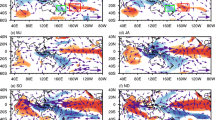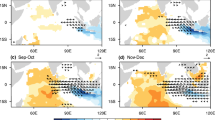Abstract
This study investigates the role of perturbation potential energy (PPE) in energetic connection between the South China Sea summer monsoon (SCSSM) and Indian Ocean dipole (IOD). When the SCSSM is strong during boreal summer, the higher and lower PPE anomalies controlled primarily by the diabatic heating correspond to negative and positive energy conversion, favoring the ascending and descending motions over western North Pacific (WNP) and southern Maritime Continent (SMC), respectively. This implies the existence of the regional Hadley circulation. This regional Hadley circulation-induced lower southeasterly wind anomalies reduce the local sea surface temperature (SST) anomalies over the tropical southeastern Indian Ocean via the wind–evaporation–SST and wind–thermocline–SST feedbacks, increasing the zonal SST gradient over the tropical Indian Ocean. Thus, a positive IOD event develops in boreal summer, and verse vice. Although the SCSSM decays during boreal autumn, the increased gradient of the PPE anomalies intensifies the anomalous Walker circulation over the tropical Indian Ocean, providing positive feedback that allows the IOD to mature. Consequently, the PPE dipole over WNP and SMC serves as an energetic bridge between the SCSSM and IOD.











Similar content being viewed by others
Date availability
NCEP/NCAR datasets were obtained from https://psl.noaa.gov/data/gridded/data.ncep.reanalysis.html; ERSST v5 downloaded at https://psl.noaa.gov/data/gridded/tables/sst.html; and SODA 2.2.4 was available at https://iridl.ldeo.columbia.edu/SOURCES/.CARTON-GIESE/.SODA/.v2p2p4/ssh/datafiles.html.
References
Ashok K, Guan ZY, Yamagata T (2003) Influence of the Indian Ocean dipole on the Australian winter rainfall. Geophys Res Lett 30:1821. https://doi.org/10.1029/2003GL017926
Behera SK, Luo JJ, Masson S, Rao SA, Sakuma H, Yamagata T (2006) A CGCM study on the interaction between IOD and ENSO. J Clim 19:1688–1705. https://doi.org/10.1175/JCLI3797.1
Bretherton CS, Widmann M, Dymnidov VP, Wallace JM, Blade I (1999) The effective number of spatial degrees of freedom of a time-varying geld. J Clim 12:1990–2009. https://doi.org/10.1175/1520-0442(1999)0122.0.CO;2
Cai WJ, Cowan T, Sullivan A (2009) Recent unprecedented skewness towards positive Indian Ocean dipole occurrences and its impact on Australian rainfall. Geophys Res Lett 36:245–253. https://doi.org/10.1029/2009GL037604
Carton JA, Giese BS (2008) A reanalysis of ocean climate using Simple Ocean Data Assimilation (SODA). Mon Weather Rev 136:2999–3017. https://doi.org/10.1175/2007MWR1978.1
Chen JP, Yu JY, Wang X, Lian T (2020) Different influences of southeastern Indian Ocean and western Indian Ocean SST anomalies on eastern China rainfall during the decaying summer of 2015/16 extreme El Niño. J Clim 33:5247–5443. https://doi.org/10.1175/JCLI-D-19-0777.1
Ding RQ, Ha KJ, Li JP (2010) Interdecadal shift in the relationship between the East Asian summer monsoon and the tropical Indian Ocean. Clim Dyn 34:1059–1071. https://doi.org/10.1007/s00382-009-0555-2
Dong D, Li JP, Huyan LD, Xue JQ (2017) Atmospheric energetics over the tropical Pacific during the ENSO cycle. J Clim 30:3635–3654. https://doi.org/10.1175/JCLI-D-16-0480.1
Edmon HJ Jr (1978) A reexamination of limited-area available potential energy budget equations. J Atmos Sci 35:1655–1659. https://doi.org/10.1175/1520-0469(1978)035,1655:AROLAA.2.0.CO;2
Gao L, Li JP, Ren HL (2006) Some characteristics of the atmosphere during an adiabatic process. Prog Nat Sci 16:644–648. https://doi.org/10.1080/10020070612330047
Guan ZY, Yamagata T (2003) The unusual summer of 1994 in East Asia: IOD teleconnections. Geophys Res Lett 30:1544. https://doi.org/10.1029/2002GL016831
Hsu PC, Li T (2011) Interactions between boreal summer intraseasonal oscillations and synoptic-scale disturbances over the Western North Pacific. Part II: apparent heat and moisture sources and eddy momentum transport. J Clim 24:942–961. https://doi.org/10.1175/2010JCLI3834.1
Huang BH, Shukla J (2007a) Mechanisms for the interannual variability in the tropical Indian Ocean. Part I: The role of remote forcing from the tropical Pacific. J Clim 20:2917–2936. https://doi.org/10.1175/JCLI4151.1
Huang BH, Shukla J (2007b) Mechanisms for the interannual variability in the tropical Indian Ocean. Part II: regional processes. J Clim 20:2937–2960. https://doi.org/10.1175/JCLI4169.1
Huang BY, Thorne PW, Banzon VF, Boyer T, Chepurin G, Lawrimore JH, Menne MJ, Smith TM, Vose RS, Zhang HM (2017) Extended reconstructed sea surface temperature, version 5 (ERSSTv5): upgrades, validations, and intercomparisons. J Clim 30:8179–8205. https://doi.org/10.1175/JCLI-D-16-0836.1
Huyan LD, Li JP, Zhao S, Sun C, Dong D, Liu T, Zhao YF (2017) The impact of layer perturbation potential energy on the East Asian summer monsoon. J Clim 30:7087–7103. https://doi.org/10.1175/JCLI-D-16-0729.1
Johnson DR (1970) The available potential energy of storms. J Atmos Sci 27:727–741. https://doi.org/10.1175/1520-0469(1970)027,0727:TAPEOS.2.0.CO;2
Kalnay E, Kanamitsu M, Kistler R, Collins W, Deaven D, Gandin L, Iredell M, Saha S, White G, Woollen J (1996) The NCEP/NCAR 40-year reanalysis project. Bull Am Meteorol Soc 77:437–471. https://doi.org/10.1175/1520-0477(1996)077%3c0437:TNYRP%3e2.0.CO;2
Kanno Y, Iwasaki T (2022) Future changes of atmospheric energy cycle in CMIP5 climate models. J Geophys Res: Atmos 127:e2021JD036380. https://doi.org/10.1029/2021JD036380
Kim YH, Kim MK (2013) Examination of the global Lorenz energy cycle using MERRA and NCEP-reanalysis 2. Clim Dyn 40:1499–1513. https://doi.org/10.1007/s00382-012-1358-4
Li JP, Gao L (2006) Theory on perturbation potential energy and its applications-concept, expression and spatio-temporal structures of perturbation potential energy (in Chinese). Chin J Geophys 30(5):834–848
Li JP, Zeng QC (2002) A unified monsoon index. Geophys Res Lett 29:1274. https://doi.org/10.1029/2001GL013874
Li JP, Zeng QC (2003) A new monsoon index and the geographical distribution of the global monsoons. Adv Atmosc Sci 20:299–302. https://doi.org/10.1007/s00376-003-0016-5
Li LM, Ingersoll AP, Jiang X, Feldman D, Yung YL (2007) Lorenz energy cycle of the global atmosphere based on reanalysis datasets. Geophys Res Lett 34:L16813. https://doi.org/10.1029/2007GL029985
Li JP, Wu ZW, Jiang ZH, He JH (2010) Can global warming strengthen the east Asian summer monsoon? J Clim 23:6696–6705. https://doi.org/10.1175/2010JCLI3434.1
Li LM, Jiang X, Chahine MT, Wang J, Yung YL (2011) The mechanical energies of the global atmosphere in El Niño and La Niña years. J Atmos Sci 68:3072–3078. https://doi.org/10.1175/JAS-D-11-072.1
Li JP, Sun C, Jin FF (2013) NAO implicated as a predictor of Northern Hemisphere mean temperature multidecadal variability. Geophys Res Lett 40:5497–5502. https://doi.org/10.1002/2013GL057877
Li JP, Zhao S, Li YJ, Wang L, Sun C (2016) On the role of perturbation potential energy in variability of the East Asian summer monsoon: Current status and prospects (in Chinese). Adv Earth Sci 31:115–125
Li J, Ding RQ, Wu ZW, Zhong QJ, Li BS, Li JP (2019) Inter-decadal change in potential predictability of the East Asian summer monsoon. Theor Appl Climatol 136:403–415. https://doi.org/10.1007/s00704-018-2482-9
Liu T, Li JP, Li YJ, Zhao S, Zheng F, Zheng JY, Yao ZX (2018) Influence of the May Southern annular mode on the South China Sea summer monsoon. Clim Dyn 51:4095–4107. https://doi.org/10.1007/s00382-017-3753-3
Lorenz EN (1955) Available potential energy and the maintenance of the general circulation. Tellus 7:157–167. https://doi.org/10.3402/tellusa.v7i2.8796
Margules M (1910) Uber die energie der stiirme (On the energy of storms). Zentralanstalt Meteor Geodyn 51:533–595
Nuncio M, Yuan X (2015) The influence of the Indian Ocean dipole on Antarctic sea ice. J Clim 28:2682–2690. https://doi.org/10.1175/JCLI-D-14-00390.1
Oort AH (1964) On estimates of the atmospheric energy cycle. Mon Weather Rev 92:483–499. https://doi.org/10.1175/1520-0493(1964)092,0483:OEOTAE.2.3.CO;2
Oort AH (1971) The observed annual cycle in the meridional transport of atmospheric energy. J Atmos Sci 28:325–339. https://doi.org/10.1175/1520-0469(1971)028,0325:TOACIT.2.0.CO;2
Oort AH, Ascher SC, Levitus S, Peixóto JP (1989) New estimates of the available potential energy in the world ocean. J Geophy Res 94:3187–3200. https://doi.org/10.1029/JC094iC03p03187
Pan Y, Li L, Jiang X, Li G, Zhang W, Wang X, Ingersoll AP (2017) Earth’s changing global atmospheric energy cycle in response to climate change. Nat Commun 8:14367. https://doi.org/10.1038/ncomms14367
Peixóto JP, Oort AH (1974) The annual distribution of atmospheric energy on a planetary scale. J Geophys Res 79:2149–2159. https://doi.org/10.1029/JC079i015p02149
Roullet G, Capet X, Maze G (2014) Global interior eddy available potential energy diagnosed from Argo floats. Geophys Res Lett 41:1651–1656. https://doi.org/10.1002/2013GL059004
Saji NH, Yamagata T (2003) Structure of SST and surface wind variability during Indian Ocean dipole mode events: COADS observations. J Clim 16:2735–2751. https://doi.org/10.1175/1520-0442(2003)016,2735:SOSASW.2.0.CO;2
Saji NH, Goswami BN, Vinayachandran PN, Yamagata T (1999) A dipole mode in the tropical Indian Ocean. Nature 401:360–363. https://doi.org/10.1038/43854
Schott FA, Xie SP, McCreary JP Jr (2009) Indian Ocean circulation and climate variability. Rev Geophys 47:RG1002. https://doi.org/10.1029/2007RG000245
Sena AC, Magnusdottir G (2021) Influence of the Indian Ocean dipole on the large-scale circulation in South America. J Clim 34:6057–6068. https://doi.org/10.1175/JCLI-D-20-0669.1
Smith PJ (1969) On the contribution of a limited region to the global energy budget. Tellus 21:202–207. https://doi.org/10.1111/j.2153-3490.1969.tb00432.x
Smith PJ, Vincent DG, Edmon HJ Jr (1977) The time dependence of reference pressure in limited region available potential energy budget equations. Tellus 29:476–480. https://doi.org/10.1111/j.2153-3490.1977.tb00759.x
Stuecker MF, Timmermann A, Jin FF, Chikamoto Y, Zhang WJ, Wittenberg AT, Widiasih E, Zhao S (2017) Revisiting ENSO/Indian Ocean dipole phase relationships. Geophys Res Lett 44:2481–2492. https://doi.org/10.1002/2016GL072308
Wang B, Huang F, Wu Z, Yang J, Fu X, Kikuchi K (2009) Multi-scale climate variability of the South China Sea monsoon: a review. Dyn Atmos Oceans 47(1):15–37. https://doi.org/10.1016/j.dynatmoce.2008.09.004
Wang L, Li JP, Guo Y (2012) Governing equations of atmospheric layer perturbation potential energy and its applications—energy budget of the South China Sea summer monsoon activity (in Chinese). Chin J Atmos Sci 36:769–783
Wang YH, Li JP, Zhang YZ, Wang QY, Qin JH (2019) Atmospheric energetics over the tropical Indian Ocean during Indian Ocean dipole events. Clim Dyn 52:6243–6256. https://doi.org/10.1007/s00382-018-4510-y
Webster PJ, Moore AM, Loschnigg JP, Leben RR (1999) Coupled ocean–atmosphere dynamics in the Indian Ocean during 1997–98. Nature 401:356–360. https://doi.org/10.1038/43848
Xie SP, Annamalai H, Schott FA, McCreary JP Jr (2002) Structure and mechanisms of south Indian Ocean climate variability. J Clim 15:864–878. https://doi.org/10.1175/1520-0442(2002)015,0864:SAMOSI.2.0.CO;2
Yamagata T, Behera SK, Rao SA, Guan ZY, Ashok K, Saji HN (2003) Comments on ‘“Dipoles, temperature gradients, and tropical climate anomalies”.’ Bull Am Meteorol Soc 84:1418–1422. https://doi.org/10.1175/BAMS-84-10-1418
Yanai M, Tomita T (1998) Seasonal and interannual variability of atmospheric heat sources and moisture sinks as determined from NCEP–NCAR reanalysis. J Clim 11:463–482. https://doi.org/10.1175/1520-0442(1998)011%3c0463:SAIVOA%3e2.0.CO;2
Yang Y, Xie SP, Wu L, Kosaka Y, Lau N, Vecchi GA (2015) Seasonality and predictability of the Indian Ocean dipole mode: ENSO forcing and internal variability. J Clim 28:8021–8036. https://doi.org/10.1175/JCLI-D-15-0078.1
Yu L (2003) Variability of the depth of the 20°C isotherm along 68°N in the Bay of Bengal: Its response to remote and local forcing and its relation to satellite SSH variability. Deep-Sea Res Part II 50:2285–2304. https://doi.org/10.1016/S0967-0645(03)00057-2
Yu P, Zhang LF, Zhong QJ (2017) An interdecadal change in the relationship between the western North Pacific Ocean and the East Asian summer monsoon. Clim Dyn 49:1139–1156. https://doi.org/10.1007/s00382-016-3370-6
Yu P, Zhang LF, Zhong QJ (2019) Contrasting relationship between the Kuroshio Extension and the East Asian summer monsoon before and after the late 1980s. Clim Dyn 52:929–950. https://doi.org/10.1007/s00382-018-4173-8
Zhang WJ, Wang Y, Jin FF, Stuecker MF, Turner AG (2015) Impact of different El Niño types on the El Niño/IOD relationship. Geophys Res Lett 42:8570–8576. https://doi.org/10.1002/2015GL065703
Zhang YZ, Li JP, Xue JQ, Feng J, Wang QY, Xu YD, Wang YH, Zheng F (2018) Impact of the south China sea summer monsoon on the Indian Ocean dipole. J Clim 31:6557–6572. https://doi.org/10.1175/JCLI-D-17-0815.1
Zhang YZ, Li JP, Wang QY, Xue JQ (2019a) Variations in atmospheric perturbation potential energy associated with the South China Sea summer monsoon. Clim Dyn 53:2295–2308. https://doi.org/10.1007/s00382-019-04845-7
Zhang YZ, Li JP, Xue JQ, Zheng F, Wu RG, Ha KJ, Feng J (2019b) The relative roles of the South China Sea summer monsoon and ENSO in the Indian Ocean dipole development. Clim Dyn 53:6665–6680. https://doi.org/10.1007/s00382-019-04953-4
Zhang YZ, Li JP, Zheng F, Yu M, Feng J, Sun C (2021) Impact of the South China Sea summer monsoon on the Indian Ocean dipole in CMIP5 models. J Clim 34:1963–1981. https://doi.org/10.1175/JCLI-D-20-0582.1
Zhou ZQ, Xie SP, Zhang RH (2021) Historic Yangtze flooding of 2020 tied to extreme Indian Ocean conditions. Proc Natl Acad Sci 118:e2022255118. https://doi.org/10.1073/pnas.2022255118
Acknowledgements
Thanks for the helpful suggestions from Dr. XG Yan. This work was jointly sponsored by the National Natural Science Foundation of China (NSFC) Project (42105055; 42130607), Shandong Natural Science Foundation Project (ZR2019ZD12), Qingdao Postdoctoral Applied Research Project (862105040041), Taishan Pandeng Scholar Project, the open fund of State Key Laboratory of Satellite Ocean Environment Dynamics, Second Institute of Oceanography, Ministry of Natural Resources (QNHX2217). Thanks for the Center for High Performance Computing and System Simulation, Laoshan Laboratory (Qingdao) for providing computing resource.
Funding
This work was jointly sponsored by the National Natural Science Foundation of China (NSFC) Project (42105055; 42130607), Shandong Natural Science Foundation Project (ZR2019ZD12), Qingdao Postdoctoral Applied Research Project (862105040041), Taishan Pandeng Scholar Project, the open fund of State Key Laboratory of Satellite Ocean Environment Dynamics, Second Institute of Oceanography, Ministry of Natural Resources (QNHX2217).
Author information
Authors and Affiliations
Contributions
YZ and JL contributed to the conceptualization and design of the study. Figures visualization and formal analysis were performed by YZ. YZ, JL, and YD analyzed and interpreted the energetic processes. The first draft of the manuscript was written by YZ, and all authors reviewed and approved the manuscript.
Corresponding authors
Ethics declarations
Competing interests
The authors declare no competing interests.
Conflict of interest
I declare that the authors have no competing interests as defined by Springer, or other interests that might be perceived to influence the results and discussion reported in this paper.
Additional information
Publisher's Note
Springer Nature remains neutral with regard to jurisdictional claims in published maps and institutional affiliations.
Rights and permissions
Springer Nature or its licensor (e.g. a society or other partner) holds exclusive rights to this article under a publishing agreement with the author(s) or other rightsholder(s); author self-archiving of the accepted manuscript version of this article is solely governed by the terms of such publishing agreement and applicable law.
About this article
Cite this article
Zhang, Y., Li, J., Diao, Y. et al. Energetic connection between the South China Sea summer monsoon and Indian Ocean dipole from the perspective of perturbation potential energy. Clim Dyn 61, 2457–2470 (2023). https://doi.org/10.1007/s00382-023-06693-y
Received:
Accepted:
Published:
Issue Date:
DOI: https://doi.org/10.1007/s00382-023-06693-y




